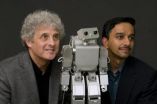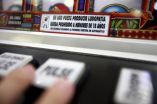(Press-News.org) Atmospheric fine particles affect the Earth's radiation balance by interacting with solar radiation and by participating in cloud formation. Biogenic volatile organic compounds are key players in new particle formation processes. Hence, terrestrial vegetation has an important role as the newly formed particles cool our climate. The chemical composition of such secondary organic aerosol (SOA) particles formed from volatile compounds emitted by vegetation is very complicated and only limited information on the phase state of SOA particles has been available. Thus the scientific community has tried to understand the chemical composition and physical characteristics of SOA particles in order to better understand their climatic implications and also to enable more accurate predictions using global climate models.
Until now, biogenic SOA particles have been represented as liquid droplets in global climate models. But according to the new research published in Nature, the physical state of SOA particles formed in coniferous forest is solid, most likely glassy soon after their formation.
-One can figure these aerosol particles as tiny children's glass marbles, says Professor Thomas Koop from Bielefeld University, Germany.
The experimental research has been conducted by the group of scientists from Finnish and German universities and institutes (Tampere University of Technology, University of Eastern Finland, Finnish meteorological institute, University of Helsinki, Bielefeld University, and Max Planck Institute for Chemistry). The discovery was made in University of Eastern Finland's experimental laboratory designed by Dr Jorma Joutsensaari.
In the experiments, fine particles formed from volatile compounds emitted by scots pines were studied under controlled conditions, and additional measurements were carried out in a coniferous forest in Hyytiälä, Finland.
The research results were achieved using a new method developed at Tampere University of Technology by Dr Annele Virtanen.
-The method is based on collecting particles by impaction on metal substrates. If the particles are solid, they bounce off the surface whereas liquid particles do not bounce but adhere to the substrate, says Virtanen.
The results will re-direct the atmospheric fine particle research
The new findings will change many features of the understanding of particle behavior in the atmosphere as the physical state of the particles influences their ability to absorb and release water and other gaseous compounds, as well as their ability to act as cloud or ice nuclei. The solid state affects also the aging and lifetime of the chemical components of air particulate matter by reducing the rates of diffusion and reaction in the particles.
-There have been some discrepancies in previous research results related to SOA particle characteristics, which might be explained by the solid state of the particles. Without doubt our results will re-direct the SOA related research worldwide, comments Professor Ari Laaksonen from Finnish Meteorological Institute.
###
For more information:
Tampere University of Technology, Finland:
Senior researcher, Dr. Annele Virtanen
tel. +358 40 198 1002
annele.virtanen(at)tut.fi
University of Eastern Finland & Finnish Meteorological Institute, Finland:
Professor Ari Laaksonen
tel. +358 40 513 7900
ari.laaksonen(at)fmi.fi
Bielefeld University, Germany:
Professor Thomas Koop
tel. +49 521 106 6135 thomas.koop(at)uni-bielefeld.de
Max Planck Institute for Chemistry, Germany:
Dr. Ulrich Pöschl
tel. +49 6131 305 422
u.poschl(at)mpic.de
Annele Virtanen, Jorma Joutsensaari, Thomas Koop, Jonna Kannosto, Pasi Yli-Pirilä, Jani Leskinen, Jyrki Mäkelä, Jarmo Holopainen, Ulrich Pöschl, Markku Kulmala, Douglas Worsnop, Ari Laaksonen: "An amorphous solid state of biogenic secondary organic aerosol particles" Nature (14th October, 2010), DOI: http://www.nature.com/nature/journal/v467/n7317/full/nature09455.html
### END
Des Moines, Iowa USA: World renowned scientists speaking at the World Food Prize Borlaug Dialogue have called for a radical transformation in the agriculture sector to cope with climate change, food security and to transition towards sustainability.
Dr Dennis Garrity, Director General of the World Agroforestry Centre and Professor MS Swaminathan, 1987 World Food Prize Laureate and founder of the MS Swaminathan Research Foundation, have teamed up to promote what they call a 'fresh out of the box solution' which is already dramatically improving crop yields while storing ...
Babies are curious about nearly everything, and they're especially interested in what their adult companions are doing. Touch your tummy, they'll touch their own tummies. Wave your hands in the air, they'll wave their own hands. Turn your head to look at a toy, they'll follow your eyes to see what's so exciting.
Curiosity drives their learning. At 18 months old, babies are intensely curious about what makes humans tick. A team of University of Washington researchers is studying how infants tell which entities are "psychological agents" that can think and feel.
Research ...
While the blood-brain barrier (BBB) protects the brain from harmful chemicals occurring naturally in the blood, it also obstructs the transport of drugs to the brain. In an article in Nature scientists at the Swedish medical university Karolinska Institutet now present a potential solution to the problem. The key to the BBB is a cell-type in the blood vessel walls called pericytes, and the researchers hope that their findings will one day contribute to new therapies for diseases like Alzheimer's and stroke.
"Our new results show that the blood-brain barrier is regulated ...
Many overseas nurses have negative experiences of living and working in the UK, particularly when it comes to feeling personally valued and professionally respected, according to the October issue of the Journal of Clinical Nursing.
Researchers from the University of Northampton also found that discrimination and racism still exist in the National Health Service and that the reality of first-world UK nursing is often very different to what overseas nurses expect.
Senior lecturer and nurse Julia Nichols and Professor of Neurophysiology Jackie Campbell carried out ...
Scientists at the University of Leeds have perfected a new technique that allows them to make molecular nanowires out of thin strips of ring-shaped molecules known as discotic liquid crystals (DLCs).
The findings could be an important step in the development of next generation electronic devices, such as light-harvesting cells and low-cost biosensors that could be used to test water quality in developing countries.
DLCs are disk-shaped molecules that are one of the more promising candidates for organic electronic devices. However, controlling their alignment has proved ...
Disorganised and emotionally unstable, poorly adapted, suffering from alcohol problems, impulsive, or with a "globally adapted" personality. These are the features of the four diagnosed types of compulsive gamblers identified by researchers at the University Hospital of Bellvitge (IDIBELL) and the Autonomous University of Barcelona (UAB). According to the scientific team, only one of these four shows signs of a significant pathology.
"We need to use different treatments for each sub-group of pathological gamblers in order to respond to their specific therapeutic difficulties ...
BEER-SHEVA, ISRAEL, October 14, 2010 -- A new study by Ben-Gurion University of the Negev (BGU) researchers predicts that a new generation of malware (software written for malicious purposes like identity theft) could steal data on human behavior patterns, which is more dangerous than traditional, detectable attacks.
In the newly published paper, "Stealing Reality," Dr. Yaniv Altschuler and Dr. Yuval Elovici from BGU discuss malware threats that extract personal information about relationships in a real-world social network, as well as characteristic information about ...
Researchers a the University of Granada and the Department of Nuclear Medicine, Hospital Virgen de las Nieves at Granada found that the metabolic imaging diagnosis technique –based on the analysis of a structural analog of glucose labeled with a positron-emitting compound (18F)– allows early diagnosis of gall bladder cancer, a relatively rare disease with high mortality rates among most patients suffering from it.
For the purpose of this study, 62 patients were subjected to this scanning method, which represents the largest sample of patients with gall bladder cancer ...
In the first half of February 2009, two asteroids collided in a region of space beyond the orbit of Mars, as scientists from the Max Planck Institute for Solar System Research (MPS) in Germany have now discovered. The researchers were able to pinpoint the exact date of the impact more precisely than ever before. The debris of the crash had attracted the attention of scientists worldwide. Together with the largest earthbound telescopes and the Hubble Space Telescope, the OSIRIS camera system onboard ESA's space probe Rosetta, that was developed and is now operated under ...
VIDEO:
New research from the Bradley Hasbro Children's Research Center may help clinicians better predict how a child with obsessive compulsive disorder (OCD) will respond to some of the most commonly...
Click here for more information.
EAST PROVIDENCE, RI – New research from the Bradley Hasbro Children's Research Center may help clinicians better predict how a child with obsessive compulsive disorder (OCD) will respond to some of the most commonly used treatment approaches. ...




